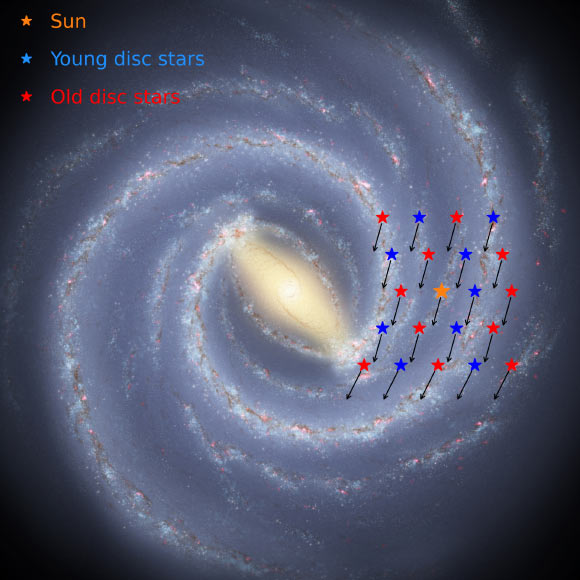[ad_1]
Using data from ESA’s Gaia mission, astronomers have found a large number of metal-poor stars older than 13 billion years on orbits similar to that of our Sun.

Rotational motion of young (blue) and old (red) stars similar to the Sun (orange). Image credit: NASA / JPL-Caltech / R. Hurt / SSC / Caltech.
“The Milky Way Galaxy has a large halo, a central bulge and bar, a thick disk and a thin disk,” said Dr. Samir Nepal from the Leibniz Institute for Astrophysics Potsdam and colleagues.
“Most stars are located in the so-called thin disk of our Milky Way and follow an organised rotation around the Galactic center.”
“Middle-aged stars such as our 4.6-billion-year-old Sun belong to the thin disk, which was generally thought to have started forming around 8 to 10 billion years ago.”
Using the new Gaia dataset, the astronomers studied stars within around 3,200 light-years from the Sun.
They discovered a surprising number of very old stars in thin disk orbits; the majority of these are older than 10 billion years, some of them even older than 13 billion years.
These ancient stars show a wide range of metal compositions: some are very metal-poor (as expected), while others have twice the metal content of our much younger Sun, indicating that a rapid metal enrichment took place in the early phase of the Milky Way’s evolution.
“These ancient stars in the disk suggest that the formation of the Milky Way’s thin disk began much earlier than previously believed, by about 4-5 billion years,” Dr. Nepal said.
“This study also highlights that our Galaxy had an intense star formation at early epochs leading to very fast metal enrichment in the inner regions and the formation of the disk.”
“This discovery aligns the Milky Way’s disk formation timeline with those of high-redshift galaxies observed by the NASA/ESA/CSA James Webb Space Telescope and the Atacama Large Millimeter Array (ALMA).”
“It indicates that cold disks can form and stabilize very early in the Universe’s history, providing new insights into the evolution of galaxies.”
“Our study suggests that the thin disk of the Milky Way may have formed much earlier than we had thought, and that its formation is strongly related to the early chemical enrichment of the innermost regions of our Galaxy,” said Dr. Cristina Chiappini, an astronomer at the Leibniz Institute for Astrophysics Potsdam.
“The combination of data from different sources and the application of advanced machine learning techniques have enabled us to increase the number of stars with high quality stellar parameters, a key step to lead our team to these new insights.”
The paper will be published in the journal Astronomy & Astrophysics.
_____
Samir Nepal et al. 2024. Discovery of the local counterpart of disc galaxies at z > 4: The oldest thin disc of the Milky Way using Gaia-RVS. A&A, in press; arXiv: 2402.00561



